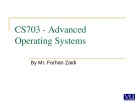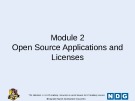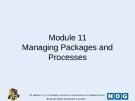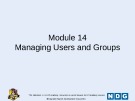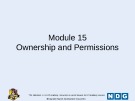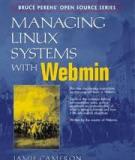
Linux module management
-
This book "CompTIA® Security+: Guide to Network Security Fundamentals" is designed to meet the needs of students and professionals who want to master basic information security. Part 2 of book provide students with knowledge about: networking threats, assessments, and defenses; network security appliances and technologies ; cloud and virtualization security; wireless network security; authentication; incident preparation, response, and investigation; cyber security resilience; risk management and data privacy;...
 336p
336p  britaikridanik
britaikridanik
 05-07-2022
05-07-2022
 32
32
 11
11
 Download
Download
-
Advanced Operating Systems - Lecture 38: Loadable kernel modules. This lecture will cover the following: loadable kernel modules and device drivers; linux module management; linux module conflict resolution; linux module registration; signals and asynchronous event notification;...
 14p
14p  haoasakura
haoasakura
 30-05-2022
30-05-2022
 13
13
 3
3
 Download
Download
-
Title of learning module: Introduction to Linux, open source applications and licenses, using Linux, command line skills, getting help, working with files and directories, archiving and compression, pipes - redirection - regex, basic scripting, understanding computer hardware, managing packages and processes, network configuration, system and user security, managing users and groups, ownership and permissions, special permissions, links and file locations.
 1p
1p  kiepnaybinhyen_02
kiepnaybinhyen_02
 29-12-2015
29-12-2015
 53
53
 1
1
 Download
Download
-
Module 2 present open source applications and licenses. Objective summary of this module: Understanding desktop, server, and mobile applications; introducing development languages and package management.
 27p
27p  kiepnaybinhyen_02
kiepnaybinhyen_02
 29-12-2015
29-12-2015
 51
51
 1
1
 Download
Download
-
Module 11 help students understanding where data is stored. After studying this chapter students should be able to: Understanding kernel and processes; logging utilities such as syslog, klog, and dmesg; information storage paths. Inviting you to refer.
 39p
39p  kiepnaybinhyen_02
kiepnaybinhyen_02
 29-12-2015
29-12-2015
 43
43
 2
2
 Download
Download
-
Module Linux essentials - Module 14 introduce managing users and groups. After studying this chapter students should be able to: Creating users and groups, understanding user and group commands, creating user IDs.
 28p
28p  kiepnaybinhyen_02
kiepnaybinhyen_02
 29-12-2015
29-12-2015
 55
55
 1
1
 Download
Download
-
Module Linux essentials - Module 15 introduce ownership and permissions in Linux. This module include content: Ownership, identity information, changing file and group ownership, permissions, chmod command, umask command.
 35p
35p  kiepnaybinhyen_02
kiepnaybinhyen_02
 29-12-2015
29-12-2015
 68
68
 4
4
 Download
Download
-
◆ Java™ Application Development on Linux® Carl Albing and Michael Schwarz C++ GUI Programming with Qt 3 Jasmin Blanchette and Mark Summerfield ◆ Managing Linux Systems with Webmin: System Administration and Module Development Jamie Cameron ◆ Understanding the Linux Virtual Memory Manager Mel Gorman ◆ PHP 5 Power Programming Andi Gutmans, Stig Bakken, and Derick Rethans ◆ Implementing CIFS: The Common Internet File System Christopher Hertel ◆ Open Source Security Tools: A Practical Guide to Security Applications...
 360p
360p  shop_123
shop_123
 08-05-2013
08-05-2013
 66
66
 7
7
 Download
Download
-
Tham khảo sách 'managing linux systems with webmin: system administration and module development', công nghệ thông tin, kỹ thuật lập trình phục vụ nhu cầu học tập, nghiên cứu và làm việc hiệu quả
 808p
808p  ringphone
ringphone
 07-05-2013
07-05-2013
 104
104
 9
9
 Download
Download
-
◆ Java™ Application Development on Linux® ◆ C++ GUI Programming with Qt 3 Jamie Cameron Carl Albing and Michael Schwarz Jasmin Blanchette and Mark Summerfield ◆ Managing Linux Systems with Webmin: System Administration and Module Development ◆ Understanding the Linux Virtual Memory Manager ◆ PHP 5 Power Programming Peter Harrison Mel Gorman Andi Gutmans, Stig Bakken, and Derick Rethans ◆ Linux® Quick Fix Notebook Christopher Hertel ◆ Implementing CIFS: The Common Internet File System ◆ Open Source Security Tools: A Practical Guide to Security Applications ◆ Apache Jakarta Commons...
 352p
352p  ringphone
ringphone
 07-05-2013
07-05-2013
 107
107
 16
16
 Download
Download
-
Linux Computing Environment 1 Objectives Upon completion of this module, you should be able to: • List the four main components of a computer • Describe the three main components of the Linux operating system • Identify the three most common shells in the Linux system • Distinguish between the multitasking, multiuser, and distributed processing capabilities of the Linux system
 200p
200p  anhchangxuixeo1002
anhchangxuixeo1002
 14-03-2013
14-03-2013
 71
71
 7
7
 Download
Download
-
Kernel Support. Core support: CPU, Memory, Process. Management , Interrupt/Exception Handling etc. Dynamically Loadable Kernel Modules. Device Drivers. Additional Functionality. User Mode Access to kernel facilities. System Calls and Signals. Filesystem Device Nodes. Network Interfaces. Are not accessed through a device node but instead are accessed. through a “network interface” abstraction.
 178p
178p  rhca_92
rhca_92
 09-11-2012
09-11-2012
 129
129
 35
35
 Download
Download
-
Linux History Design Principles Kernel Modules Process Management Scheduling Memory Management File Systems Input and Output Interprocess Communication Network Structure Security To explore the history of the UNIX operating system from which Linux is derived and the principles which Linux is designed upon To examine the Linux process model and illustrate how Linux schedules processes and provides interprocess communication To look at memory management in Linux To explore how Linux implements file systems and manages I/O devices...
 62p
62p  perpan
perpan
 02-09-2012
02-09-2012
 75
75
 15
15
 Download
Download
-
Written by the creator of Webmin, this book explains how to use the most popular Webmin modules to perform common administration tasks on a Linux system such as adding users, configuring Apache, setting up NFS file sharing and managing the Sendmail mail server.Each chapter covers a single server or service, and is broken down into sections that list the steps required to carry out certain tasks using Webmin.
 808p
808p  fangfangfang
fangfangfang
 24-03-2012
24-03-2012
 182
182
 54
54
 Download
Download
-
History Design Principles Kernel Modules Process Management Scheduling Memory Management File Systems Input and Output Interprocess Communication Network Structure Security History Linux is a modem, free operating system based on UNIX standards. First developed as a small but self-contained kernel in 1991 by Linus Torvalds, with the major design goal of UNIX compatibility. Its history has been one of collaboration by many users from all around the world, corresponding almost exclusively over the Internet.
 10p
10p  kanguru_91
kanguru_91
 28-09-2010
28-09-2010
 136
136
 22
22
 Download
Download
-
In this chapter, you will learn how to manage Linux in advanced installation and configuration scenarios. The installation topics cover creating automated installation scripts and managing kernel modules. You will learn how to implement a Redundant Array of Inexpensive Disks (RAID), as well as an array of disks for the Logical Volume Manager (LVM), and master the intricate details of the automated Kickstart installation process. Finally, you’ll get a basic sense of how you can modularize the kernel to your advantage....
 46p
46p  mylinh
mylinh
 17-08-2009
17-08-2009
 114
114
 12
12
 Download
Download
CHỦ ĐỀ BẠN MUỐN TÌM









